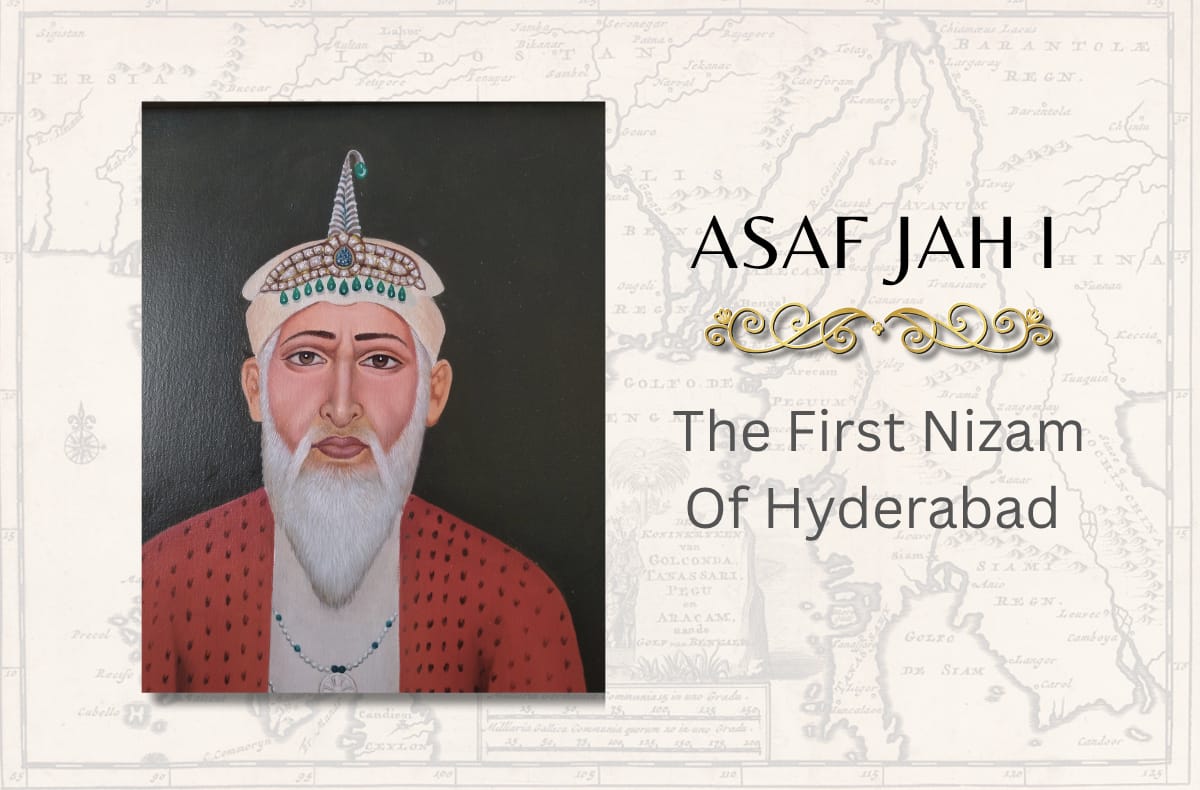Asaf Jah I (Mir Qamar-ud-Din Khan), the founder of the Asaf Jahi dynasty and first Nizam of Hyderabad – was responsible for setting up a strong foundation, for the administration of Hyderabad.
As the first Nizam of Hyderabad, he established a strong and efficient administration in the Deccan region during the early 18th century. His process of setting up governance was shaped by his Mughal experience and his need to control a vast and diverse territory after the decline of centralized Mughal power.
*ASAF JAH 1 BACKGROUND*
Asaf Jah I had served under Aurangzeb and other Mughal emperors as a Mansabdar and governor of provinces like the Deccan and Gujarat. He adopted Mughal administrative principles but modified them to suit local conditions. It was important to start the reign of the Nizams on a strong footing. Asaf Jah 1 was fully aware that the deccan region, covered a wide area that was diverse in many respects.
*ESTABLISHMENT OF AUTONOMY (1724)*
If Asaf Jah 1 was to have a total grip on the administration of Hyderabad, it would be necessary for him to ensure that the Mughal influence was minimal. In 1724, he defeated Mubariz Khan, the Mughal governor of the Deccan, and declared de facto independence while maintaining nominal loyalty to the Mughal emperor. This marked the beginning of his own rule as the Nizam of Hyderabad.
The reduction in the influence of the Mughals, significantly ensured that Nizams could reign for many centuries, effectively until 1948. This was when the Indian government, declared Hyderabad as being a part of India.
*HYDERABAD AS CAPITAL*
He chose Hyderabad as the capital, strategically located and rich in resources. A centralized bureaucracy was set up with direct control over tax collection, law, and military matters.
Under the Nizam rule (Asaf Jahi dynasty) from 1724 to 1948, Hyderabad developed significantly in terms of economy, administration, and culture. Starting from Asaf Jah I, the Nizams maintained relative stability and independence, which helped the state prosper even while the rest of India saw political turmoil. Much of this positive development, was possible due to the foresight shown by Asaf Jah 1.
*ADMINISTRATIVE DIVISIONS*
The region was divided into subahs (provinces) and districts, each administered by appointed officials who were responsible for law and order, revenue, and defense. Officials included Faujdars (military commanders) and Amils (revenue officers).
Historic narrations claim that, starting with the first Nizam and going all the way to the last Nizam (seventh), officials were handpicked based solely in integrity and capability.
*REVENUE AND TAXATION*
Asaf Jah I adopted a fair revenue system based on land measurement and productivity, inspired by Mughal revenue systems (like Todar Mal’s). Tax collection was monitored to prevent corruption and ensure efficient functioning.
The economy of the region developed and tax collection, showed proportionate growth. The Nizams had a fairly efficient process to segregate, the wealth of the state from the personal treasury of the Nizams.
*MILITARY REFORMS*
The first Nizam, Asaf Jah 1 realized the importance of security and the need to be alert to external aggression. He maintained a strong military with loyal commanders and soldiers, which helped keep local chieftains and rebellious nobles under control. He also employed mercenary forces (including Marathas and Arabs) and ensured their loyalty through timely payments and rewards.
Good revenue for the state made it possible, to maintain a strong and motivated military. Subsequent Nizams, starting with Asaf Jah II entered into negotiations with the French and British. These negotiations revolved around, getting military protection from the organized security setup of the two nations.
While the French and British did charge the Nizams for providing security, the overall cost and effectiveness seemed to have pleased the Nizam and his security advisors. Reports claim that a rare fancy vivid blue diamond known as the Seraphim Blue Diamond, was handed over to the French – this as (part of full) payment, for security support. The blue diamond is believed to have been, set in an opulent turban ornament worn by Asaf Jah 1. The diamond exited the treasury of the Nizams when, Asaf Jah II as the second Nizam of Hyderabad, hand over the Seraphim Blue Diamond to the French.
*RELIGIOUS TOLERANCE*
Although a Sunni Muslim, Asaf Jah I followed a policy of religious tolerance and employed Hindus in various administrative roles. This approach helped in maintaining harmony in a religiously diverse region.
Communal tensions based on religious differences, were largely absent or well under control during the Nizam rule. Many experts claim that, this reduced the strain on internal security.
*LONG LASTING LEGACY*
The administrative structure for Hyderabad, laid by Asaf Jah I remained largely intact and was followed by his successors, helping Hyderabad become one of the most stable princely states in India.







